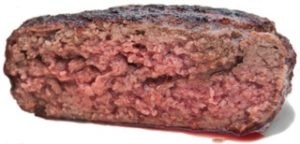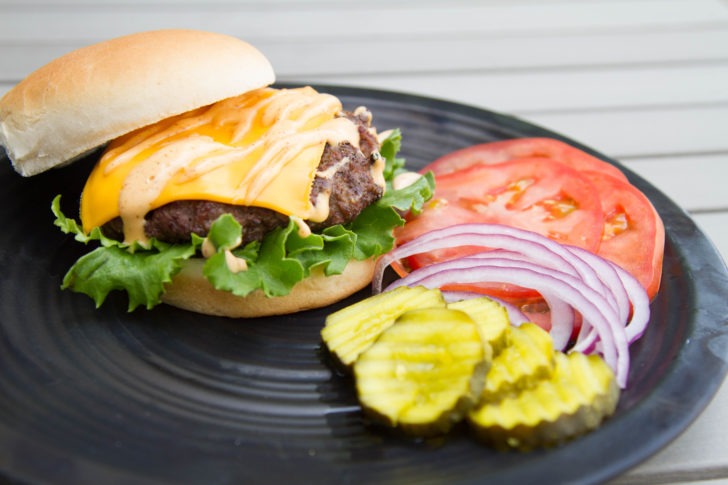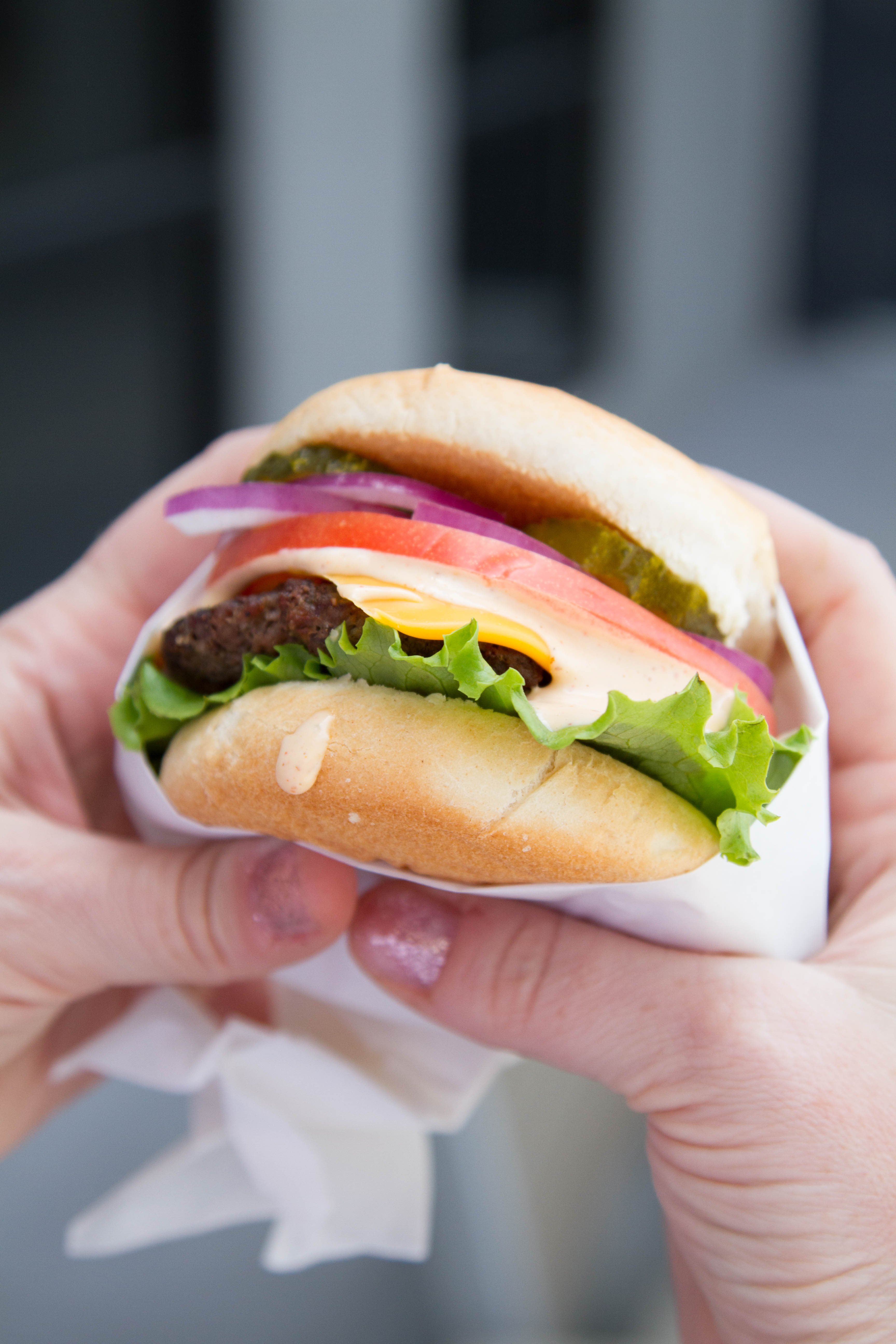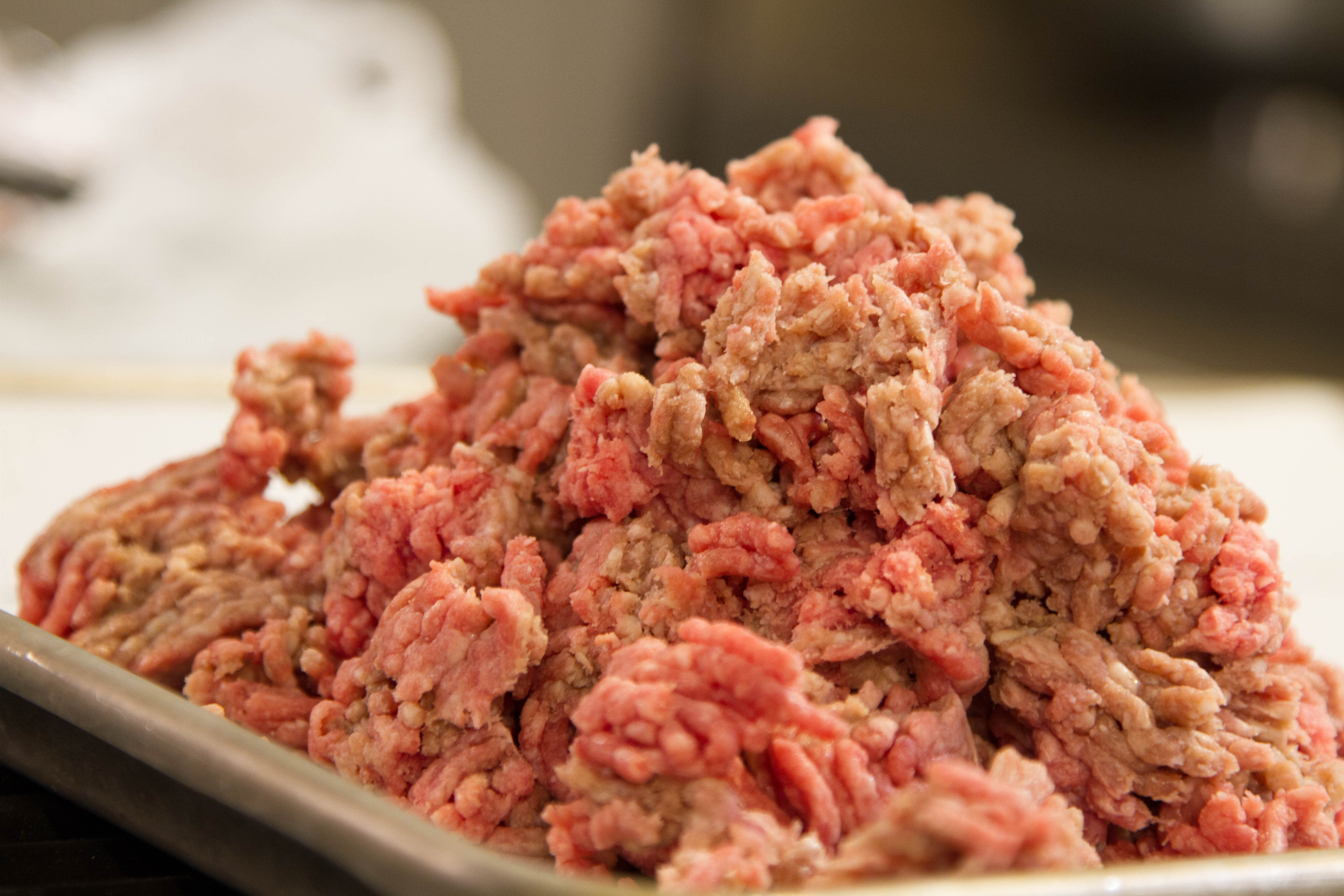Moist and Flavorful Burgers That Are Also Safe to Eat
Medium? Or medium rare? Anyone who takes steak seriously knows the answer to that question. Steaks cooked to medium rare (130° F, see Chef Recommended Temps) simply taste better and have a better texture.
So why do we cook our hamburgers to 160°? As the old A-1 commercial used to say, “What are hamburgers, chopped ham?? No, they’re chopped steak!” Wouldn’t hamburgers cooked to 130°F taste moister and more flavorful?? The answer is a resounding yes!
The painful truth is that we cook our hamburgers to 160°F because of bacteria.
As Chef Bruce Aidells points out in his book The Great Meat Cookbook, whole cuts of meat, like steaks, only develop harmful bacteria associated with raw beef like E. coli on their outer surface, which just happens to be the part of the cut that is exposed to the most intense heat in the grilling or cooking process. No problem.
But in the grinding process, that surface bacteria gets mixed throughout the hamburger meat. Hence the USDA recommends bringing the center of the burger up to 160°F, or well done, to kill the bacteria in the center of the burger.
There is a better way. Are you ready??
Option 1: Pasteurization
In his book Cooking for Geeks, Jeff Potter explains one way around this problem: “…if you have a way of cooking your burger to a lower temperature and then holding it at temperature long enough to pasteurize it, you could avoid denaturing the actin proteins while still pasteurizing the meat.”
Translation: if you can get your burgers to 140°F internal temperature and then hold them there for 12 minutes you can kill the bacteria without overcooking your burger (as recommended by the Hospitality Institute of Technology and Management).
Here’s how…
Step 1: Turn on your oven and bring it to a warming temperature of 140°F
Step 2: Grill your burgers to an internal temperature of 140°F (or even 138°F since the internal temperature of the burgers will continue to rise during the resting phase)
Step 3: Place your burgers on an oven-proof tray, wrap them with tin foil and place them in the warm oven
Step 4: Immediately after placing the foil wrapped burgers in the oven, turn the oven off, close the oven door, and let the burgers “rest” for 12 minutes before enjoying
Option 2: Grind Your Own
But for real meat lovers, 140°F is still too high.
The fact of the matter is you can actually safely grill and eat a moist juicy hamburger at 130°F internal temperature (medium rare) if you bypass what Bruce Aidells calls “the germ-filled environment of the butcher shop or packinghouse” altogether.
Yep, we’re talking grinding your own beef.
Here’s how…
Step 1: Select the blend of meat you wish to grind (J. Kenji López-Alt of Serious Eats recommends equal parts beef sirloin and brisket and oxtail, but here’s his rundown of cuts to use: Mastering the Art of Burger Blending)
Step 2: Cube your meat into 1 inch squares
Step 3: Professional chef and food scientist, Harold McGee recommends “blanching” the cubes of meat to remove any surface bacteria by bringing a large pot to boil…
Step 4: …and then immersing each piece of meat for 30-60 seconds before removing them and patting them dry
Step 5: Grind the meat in your home meat grinder or food processor
Step 6: Form patties and grill them to a succulent 130°F (medium rare) and enjoy
Because the environment of home-ground burgers (i.e. your kitchen) can be controlled in such a way that there’s limited exposure to harmful bio-contaminants, cooking the hamburger to lower temperatures should not be a problem. If you grind your own burgers and want to grill them to your perceft desired temperature, read our post on grilling perfect burgers!

__________________________________________________________
Cited:
Aidells, Bruce. The Great Meat Cookbook.
Potter, Jeff. Cooking for Geeks: Real Science, Great Hacks, and Good Food.
López-Alt , J. Kenji. Mastering the Art of Burger Blending with Eight Cuts of Beef
McGee, Harold. On Food and Cooking: The Science and Lore of the Kitchen.
Food Safety Hazards and Controls for the Home Food Preparer. 10/30/08 print 10/30/08 © HITM 1994 Jun 06 edition
Updated Post from May 23, 2013





I love this article, because to me “juicy” is necessary to a great burger. Over the years, I’ve taken my chances with under-cooked burgers, and although a little nervous, it always turned out okay. I didn’t get sick from it. Perhaps a little fatter maybe, but not sick.
I’ve recently joined the Sous Vide crowd and a Sous Vide hamburger is high on the list to try. This article from Serious Eats explains how to cook one Sous Vide style.
Because I cook everything on my Big Green Egg, I’m trying to merge the Sous Vide process with the magic of the Egg. So far, so good.
But one thing is for sure, I absolutely depend on my Thermapen for every step of the process. I want to make sure I know the temperature of the Sous Vide bath water and the final temperature of the seared meat. I trust the Thermapen.
Thanks to you guys, I’m a better cook. And the good part is that I’m getting better at it everyday with your tools and tips.
Leroy McMillin
aka Spring Chicken
Spring Texas USA
Thanks for the great comments, Spring Chicken! We LOVE that you love your Thermapen as integral part of your approach to getting great results. Yes sous vide is a great approach to this problem, and one that we have mentioned before, repeatedly, and will continue to explore. Look for additionally posts on sous vide burgers in the future! And happy experimenting!
I agree 100% with your view on over cooked burgers (and really any meat or fish). There isn’t anything better than a juicy, moist, flavorful burger at 135F! Most people have never experienced one and rave over it once they have! But I do slightly disagree with your methods to achieve it, plus you left out the best (and safest) method, Sous Vide!
Option #1 is hard to execute because most ovens can’t maintain 140F with any degree of accuracy and without significant temperature swings. Many will move more than 10 or 15 degrees between high and low. This ends up foiling your best efforts for a world class burger. Plus it isn’t really safe when you don’t really know what temp it is at.
Option #2 is a great method, but can’t be used with a butcher or store grind, and as much as I LOVE grinding my own blend of burger, there just isn’t time to always do it! Plus it is a bit of work and a mess. This is why my go to method for not only burgers, but any meat or fish is Sous Vide!
Just slide any burger (store bought or home grind) into a sous vide bag and cook sous vide for about an hour at 135F. Remove the burger and do a quick sear and your burger will be perfect and safe! An hour for a 3/8″ burger at 135F will result in a fully pasturized burger. Thicker burgers will take longer. I use the app “Sous Vide Dash” to calculate safe temps for any meat or poultry. They tell you exactly how long to cook to pasturize to the core, killing all pathogens.
Sous vide circulators are readily available now in many types and models for around $150. Personally I like the Anova.
Try Sous Vide once and you will never go back to dry bland meat!
I purchased one of you products. It was not cheap but I have been so happy with my results using it. I have told many people about your products and site.
Thanks,
Jerry
Is there any freezing process that can be used to kill harmful bacteria in either solid cuts or ground beef?
To kill bacteria, you typically have to reach 80 degrees below freezing. Home freezers don’t get cold enough.
No.
One other option…..for the perfect medium rare burger. SOUS VIDE Pasturized and perfectly cooked to 128 then a quick sear in an iron skellet.
Wow, Jerry, that means a lot. Thermoworks is a small business dedicated to quality products and we depend upon the good word of customers like you!
I have purchased several of your products. I would not start to cook a cut of meat without a Thermapen. I have the alarms for cooking in the ovens, and the one that tells the temperature of the grill and the meat. I have given them to my boys and told several of my friends about them. They have kept my wife happy when she wants hers well done. I protest but a happy wife is a happy life….
Good ideas, my only critique other than adding sous vide as already mentioned, cooking to 140 as option 1 suggests will work, but you will be miising out on the tastiest part of grilling, the sear to get that beautiful char! I cook mine on the grill, indirect at as low of a temp as I can hold my weber kettle (about 200 or so) and check temps constantly with my thermapen until I get to 120-125deg. Then remove the lid for a few minutes to get my coals very hot and sear the burgers directly over the coals for a couple of minutes each side. With some practice, I can get a consistant 135-140 deg internal temp and a solid medium doneness and still a great char on the outside. Burgers stay juicy and the longer slower cook I am confident kills any bacteria that would otherwise be present cooking faster. Been doing this way for a long time and haven’t had any issues and constantly get complimented on my burgers.
Hi Bryan, You are right that the bread and milk don t add flavor but they do keep the burgers tender and juicy.
I would suggest doing the “blanching” step BEFORE cubing the meat (lower surface-to-volume ratio)